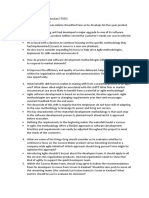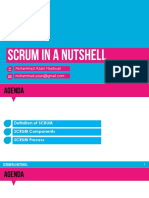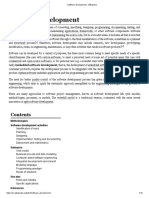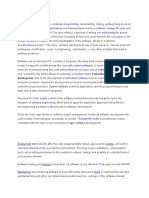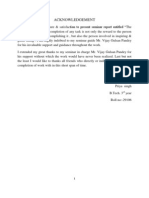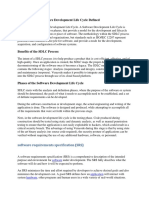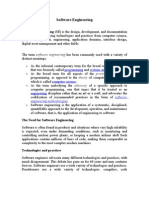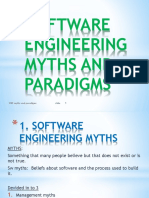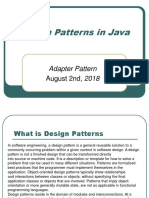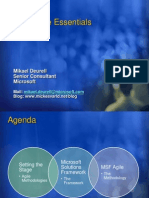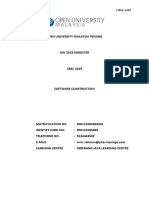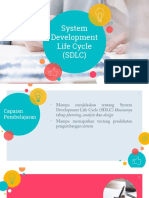Software Development
Software Development
Uploaded by
Jojo Conceso EllaCopyright:
Available Formats
Software Development
Software Development
Uploaded by
Jojo Conceso EllaCopyright
Available Formats
Share this document
Did you find this document useful?
Is this content inappropriate?
Copyright:
Available Formats
Software Development
Software Development
Uploaded by
Jojo Conceso EllaCopyright:
Available Formats
Software development (also known as application development, software design, designing software, software application development, enterprise application
development, or platform development[1]) is the development of a software product. The term "software development" may be used to refer to the activity of computer programming, which is the process of writing and maintaining the source code, but in a broader sense of the term it includes all that is involved between the conception of the desired software through to the final manifestation of the software, ideally in a planned and structured process.[2] Therefore, software development may include research, new development, prototyping, modification, reuse, re-engineering, maintenance, or any other activities that result in software products.[3] A software development process, also known as a software development life cycle (SDLC), is a structure imposed on the development of a software product. Similar terms include software life cycle and software process. It is often considered a subset of systems development life cycle. There are several models for such processes, each describing approaches to a variety of tasks or activities that take place during the process. Some people consider a lifecycle model a more general term and a software development process a more specific term. For example, there are many specific software development processes that 'fit' the spiral lifecycle model. ISO 12207 is an ISO standard for software lifecycle processes. It aims to be the standard that defines all the tasks required for developing and maintaining software.
Software development activities The activities of the software development process represented in the waterfall model. There are several other models to represent this process. Planning An important task in creating a software product is extracting the requirements or requirements analysis. Customers typically have an abstract idea of what they want as an end result, but not what software should do. Incomplete, ambiguous, or even contradictory requirements are recognized by skilled and experienced software engineers at this point. Frequently demonstrating live code may help reduce the risk that the requirements are incorrect. Once the general requirements are gathered from the client, an analysis of the scope of the development should be determined and clearly stated. This is often called a scope document. Certain functionality may be out of scope of the project as a function of cost or as a result of unclear requirements at the start of development. If the development is done externally, this document can be considered a legal document so that if there are ever disputes, any ambiguity of what was promised to the client can be clarified. Implementation, testing and documenting Implementation is the part of the process where software engineers actually program the code for the project. Software testing is an integral and important phase of the software development process. This part of the process ensures that defects are recognized as soon as possible. Documenting the internal design of software for the purpose of future maintenance and enhancement is done throughout development. This may also include the writing of an API, be it external or internal. It is very important to document everything in the project. Deployment and maintenance
Deployment starts after the code is appropriately tested, is approved for release and sold or otherwise distributed into a production environment. Software Training and Support is important and a lot of developers fail to realize that. It would not matter how much time and planning a development team puts into creating software if nobody in an organization ends up using it. People are often resistant to change and avoid venturing into an unfamiliar area, so as a part of the deployment phase, it is very important to have training classes for new clients of your software. Maintaining and enhancing software to cope with newly discovered problems or new requirements can take far more time than the initial development of the software. It may be necessary to add code that does not fit the original design to correct an unforeseen problem or it may be that a customer is requesting more functionality and code can be added to accommodate their requests. If the labor cost of the maintenance phase exceeds 25% of the prior-phases' labor cost, then it is likely that the overall quality of at least one prior phase is poor.[citation needed] In that case, management should consider the option of rebuilding the system (or portions) before maintenance cost is out of control. Agile Software Development is a group of software development methodologies based on iterative and incremental development, where requirements and solutions evolve through collaboration between self-organizing, crossfunctional teams. The Cleanroom Software Engineering process is a software development process intended to produce software with a certifiable level of reliability. The basic principles of the Cleanroom process are Software development based on formal methods,Incremental implementation under statistical quality control, & Statistically sound testing Iterative and Incremental development is at the heart of a cyclic software development process developed in response to the weaknesses of the waterfall model. It starts with an initial planning and ends with deployment with the cyclic interactions in between.Iterative and incremental development are essential parts of the Rational Unified Process, Extreme Programming and generally the various agile software development frameworks.It follows a similar process to the plan-do-check-act cycle of business process improvement. Rapid application development (RAD) is a software development methodology that uses minimal planning in favor of rapid prototyping. The "planning" of software developed using RAD is interleaved with writing the software itself. The lack of extensive pre-planning generally allows software to be written much faster, and makes it easier to change requirements. The Rational Unified Process (RUP) is an iterative software development process framework created by the Rational Software Corporation, a division of IBM since 2003.[1] RUP is not a single concrete prescriptive process, but rather an adaptable process framework, intended to be tailored by the development organizations and software project teams that will select the elements of the process that are appropriate for their needs. The spiral model is a software development process combining elements of both design and prototyping-in-stages, in an effort to combine advantages of top-down and bottom-up concepts. Also known as the spiral lifecycle model (or spiral development), it is a systems development method (SDM) used in information technology (IT). This model of development combines the features of the prototyping model and the waterfall model. The waterfall model is a sequential design process, often used in software development processes, in which progress is seen as flowing steadily downwards (like a waterfall) through the phases of Conception, Initiation, Analysis, Design, Construction, Testing, Production/Implementation and Maintenance. Extreme Programming (XP) is a software development methodology which is intended to improve software quality and responsiveness to changing customer requirements. As a type of agile software development,[1][2][3] it advocates frequent "releases" in short development cycles (timeboxing), which is intended to improve productivity and introduce checkpoints where new customer requirements can be adopted.
Lean software development is a translation of Lean manufacturing and Lean IT principles and practices to the software development domain. Scrum is an iterative, incremental framework for project management focused on the management of software development projects, and it can be used to run software maintenance teams or as a general project/program management approach. The V-model represents typical V shape. The V-Model demonstrates the relationships between each phase of the development life cycle and its associated phase of testing. The horizontal and vertical axes represents time or project completeness (left-to-right) and level of abstraction (coarsest-grain abstraction uppermost), respectively. Test-driven development (TDD) is a software development process that relies on the repetition of a very short development cycle: first the developer writes a failing automated test case that defines a desired improvement or new function, then produces code to pass that test and finally refactors the new code to acceptable standards.Programmers also apply the concept to improving and debugging legacy code developed with older techniques.[4] Agile methods break tasks into small increments with minimal planning, and do not directly involve long-term planning. Iterations are short time frames (timeboxes) that typically last from one to four weeks. Each iteration involves a team working through a full software development cycle including planning, requirements analysis, design, coding, unit testing, and acceptance testing when a working product is demonstrated to stakeholders. This minimizes overall risk and allows the project to adapt to changes quickly. Scrum is a process skeleton that contains sets of practices and predefined roles. The main roles in Scrum are:
1. the ScrumMaster, who maintains the processes (typically in lieu of a project manager) 2. the Product Owner, who represents the stakeholders and the business 3. the Team, a cross-functional group of about 7 people who do the actual analysis, design, implementation,
testing, etc.
You might also like
- Pearson'sDocument2 pagesPearson'sAkshaya LakshminarasimhanNo ratings yet
- Muhammad Azani HasibuanDocument27 pagesMuhammad Azani HasibuanArif RaihanNo ratings yet
- Software Development ProcessDocument2 pagesSoftware Development ProcessUppamjot SinghNo ratings yet
- Software DevelopmentDocument10 pagesSoftware Developmentjustin time compilerNo ratings yet
- Module 5 - Reading5 - SystemDevelopmentDocument13 pagesModule 5 - Reading5 - SystemDevelopmentChristopher AdvinculaNo ratings yet
- Software DevelopmentDocument10 pagesSoftware Developmentrudy_tanagaNo ratings yet
- APPDEV Chapter 2Document9 pagesAPPDEV Chapter 2Arjay BalberanNo ratings yet
- Software Development ProcessDocument8 pagesSoftware Development Processujjwal123456No ratings yet
- SDLC - 7 PhasesDocument4 pagesSDLC - 7 PhasesDavis EdwardNo ratings yet
- HS Solved Paper 2Document6 pagesHS Solved Paper 2caNo ratings yet
- Unit-1 - Software Process ModelDocument61 pagesUnit-1 - Software Process Model21EBKCS048Jyotsna BishtNo ratings yet
- 1.software DevelopmentDocument6 pages1.software DevelopmentAna Pociello SamperizNo ratings yet
- Relation To Methods and TheoriesDocument18 pagesRelation To Methods and TheoriesMercy Santôsildes DaracanNo ratings yet
- XP FinalDocument92 pagesXP Finaldeepoo1830No ratings yet
- Software Development Life Cycle (SDLC)Document25 pagesSoftware Development Life Cycle (SDLC)Al Muktadir MunamNo ratings yet
- SPM Unit-2ndDocument24 pagesSPM Unit-2ndakshan09061999No ratings yet
- Unit-2, SPMDocument46 pagesUnit-2, SPMAkshay DwivediNo ratings yet
- Illustrate The Umbrella Activities of A Software ProcessDocument12 pagesIllustrate The Umbrella Activities of A Software ProcessGautham SajuNo ratings yet
- SDLC NotesDocument8 pagesSDLC Notesrushty decenaNo ratings yet
- SDCL Pract 3Document6 pagesSDCL Pract 3Mahesh DarvankarNo ratings yet
- SDLC ModelsDocument7 pagesSDLC ModelsAmit Rathi100% (7)
- Software EngineeringDocument8 pagesSoftware Engineeringnigamshreya2004No ratings yet
- Software Engineering Lab ManualDocument23 pagesSoftware Engineering Lab Manualdileepvk197860% (5)
- Software Development Is The: Citation NeededDocument3 pagesSoftware Development Is The: Citation NeededKimane Ecclectic LeslieNo ratings yet
- WaterfallDocument17 pagesWaterfallavinash29105No ratings yet
- PRESENTED BY Ankita Seth Depertment Cse Class Roll 016 REGISTRATION NO 092360110006 ROLL NO 09236001031Document19 pagesPRESENTED BY Ankita Seth Depertment Cse Class Roll 016 REGISTRATION NO 092360110006 ROLL NO 09236001031Ankita SethNo ratings yet
- What Is SDLC - Phases of Software Development & ModelsDocument8 pagesWhat Is SDLC - Phases of Software Development & ModelsSarange AnneNo ratings yet
- Software Engineering Is An Engineering Branch Associated With Development of Software Product Using WellDocument20 pagesSoftware Engineering Is An Engineering Branch Associated With Development of Software Product Using WellJiru AlemayehuNo ratings yet
- Software Development Life Cycle PDFDocument5 pagesSoftware Development Life Cycle PDFAadil latiefNo ratings yet
- What Is SDLCDocument3 pagesWhat Is SDLCsalmanNo ratings yet
- OOSEDocument99 pagesOOSE21itboopathi007No ratings yet
- Introduction To Software EngineeringDocument10 pagesIntroduction To Software Engineeringgd2782001No ratings yet
- Raja R. Information Systems Management 2023Document181 pagesRaja R. Information Systems Management 2023kuba.legerskiNo ratings yet
- Software-Engineering Lecture - 02 - NotesDocument11 pagesSoftware-Engineering Lecture - 02 - Notesarishmakhalid838No ratings yet
- Software Development Life CycleDocument8 pagesSoftware Development Life Cycleapi-320326008No ratings yet
- FSeng Chapter 3 - Agile DevelopmentDocument18 pagesFSeng Chapter 3 - Agile DevelopmentSura OGNo ratings yet
- Software Engineering by John PerelessDocument3 pagesSoftware Engineering by John PerelessVikas TailorNo ratings yet
- Bca C104 SM02Document7 pagesBca C104 SM02mfstore9548No ratings yet
- B.SC TY VTH Sem Practical 2023-24Document24 pagesB.SC TY VTH Sem Practical 2023-24rajthorat102003No ratings yet
- OOAD Lecture 3Document12 pagesOOAD Lecture 3M AliNo ratings yet
- Presentation On SDLC (Software Development Life Cycle)Document19 pagesPresentation On SDLC (Software Development Life Cycle)Shailu SinghNo ratings yet
- Unit - 1: Software Product and SDLCDocument15 pagesUnit - 1: Software Product and SDLCsirqaimNo ratings yet
- WaterfallDocument6 pagesWaterfallfaeghehnaiollahiNo ratings yet
- SCRUMDocument12 pagesSCRUMburek.mirabellaNo ratings yet
- The Stages of SDLC Are As Follows:: SE Unit-2 SDLC and Process ModelsDocument12 pagesThe Stages of SDLC Are As Follows:: SE Unit-2 SDLC and Process ModelsRushmitha SelvarajNo ratings yet
- Software AssignmentDocument5 pagesSoftware AssignmentfewfNo ratings yet
- Assignment No 1Document2 pagesAssignment No 1Dave Bryan Joseph BeatingoNo ratings yet
- Software Process Model Part 1 25Document18 pagesSoftware Process Model Part 1 25SANDEEP SinghNo ratings yet
- Prac 1 To 3Document43 pagesPrac 1 To 3kmnlopq29No ratings yet
- Unit 1Document19 pagesUnit 1Rajyalakshmi KolliparaNo ratings yet
- Software Processes: Software Specifications:functionality Software Development: TheDocument90 pagesSoftware Processes: Software Specifications:functionality Software Development: TheNgay Tro VeNo ratings yet
- Software Testing TechniquesDocument191 pagesSoftware Testing TechniquesAnant MoreNo ratings yet
- Neww SSSRRRTTTT PDFDocument1 pageNeww SSSRRRTTTT PDFkaranpatil488pistaNo ratings yet
- Software Engineering: Software Engineering (SE) Is The Design, Development, and DocumentationDocument11 pagesSoftware Engineering: Software Engineering (SE) Is The Design, Development, and Documentationajay_riderNo ratings yet
- Software DevelopmentDocument43 pagesSoftware DevelopmentYash BhardwajNo ratings yet
- Chapter 2 Software ProcessesDocument21 pagesChapter 2 Software ProcessesMilkessaAddunyaaKanaaNo ratings yet
- IT Knowledge ExchangeDocument14 pagesIT Knowledge ExchangeLavanyaNo ratings yet
- Software Engineering: SubjectDocument7 pagesSoftware Engineering: SubjectDibyam DeyNo ratings yet
- Software Engineering Notes 123456Document17 pagesSoftware Engineering Notes 123456Rahul GuptaNo ratings yet
- Software Testing Interview Questions You'll Most Likely Be AskedFrom EverandSoftware Testing Interview Questions You'll Most Likely Be AskedNo ratings yet
- Scrum MasteryDocument5 pagesScrum MasteryCarlos VeraNo ratings yet
- Agile 2Document86 pagesAgile 2Abdelrahman EladawyNo ratings yet
- Software Engineering Myths and ParadigmsDocument17 pagesSoftware Engineering Myths and ParadigmsMAMO EMIRUNo ratings yet
- Cs8592-Object Oriented Analysis and DesignDocument8 pagesCs8592-Object Oriented Analysis and DesignpradeepaNo ratings yet
- 4 5814457855524210967Document78 pages4 5814457855524210967gnuga12417No ratings yet
- Adapter Design PatternsDocument16 pagesAdapter Design Patternshemale kameNo ratings yet
- Advantages and Disadvantages of SDLC MethodolgoyDocument5 pagesAdvantages and Disadvantages of SDLC MethodolgoyPushkar PhatakNo ratings yet
- MSF Agile EssentialsDocument54 pagesMSF Agile EssentialsJuan MolinaNo ratings yet
- Software ConstructionDocument12 pagesSoftware ConstructionTru CommuniqueNo ratings yet
- SCRUM (Mind Mapping)Document1 pageSCRUM (Mind Mapping)Rounak VijayNo ratings yet
- Scrum Anti Patterns Guide v564 2022 06 12Document107 pagesScrum Anti Patterns Guide v564 2022 06 12meroka2000No ratings yet
- Agile Poster 2016 Ver10Document1 pageAgile Poster 2016 Ver10vinnod5010100% (1)
- Scrum Checklist Prio1 PDFDocument1 pageScrum Checklist Prio1 PDFvsrajeshvsNo ratings yet
- System DiagrmDocument11 pagesSystem Diagrmermiyasgr27No ratings yet
- Agile Interview Questions and AnswersDocument4 pagesAgile Interview Questions and AnswersSuraj Premnath100% (2)
- Velocity Chart TemplateDocument4 pagesVelocity Chart TemplateMohanbabuPadmanabhanNo ratings yet
- Iterative and Incremental DevelopmentDocument4 pagesIterative and Incremental DevelopmentheenadttNo ratings yet
- Agile 2Document7 pagesAgile 2Nagaraj RNo ratings yet
- Scrum and CMMI: A High Level Assessment of Compatibility: Empirical, Since It IsDocument7 pagesScrum and CMMI: A High Level Assessment of Compatibility: Empirical, Since It IsDo Dang TuanNo ratings yet
- Error PageDocument5 pagesError PageSaurabh SonkusareNo ratings yet
- Technical Seminar On Agile MethodologyDocument32 pagesTechnical Seminar On Agile MethodologySHIVASAINo ratings yet
- Developer AnswersDocument9 pagesDeveloper AnswerssholihaturrahmahNo ratings yet
- Pepper: Chapter 3 - Agile Software DevelopmentDocument27 pagesPepper: Chapter 3 - Agile Software DevelopmentDilip KumarNo ratings yet
- Starting A Devops Transformation: Breaking Down Walls Between People, Process, and ProductsDocument26 pagesStarting A Devops Transformation: Breaking Down Walls Between People, Process, and ProductsRehan AzherNo ratings yet
- 1 JavaScript FrameworksDocument9 pages1 JavaScript Frameworksalipo bannyNo ratings yet
- Agile DevelDocument32 pagesAgile DevelMarco CapizziNo ratings yet
- System Development Life Cycle (SDLC)Document44 pagesSystem Development Life Cycle (SDLC)adeo paleviNo ratings yet
- Agile Starter Kit v1.1Document16 pagesAgile Starter Kit v1.1gauravcb7No ratings yet
